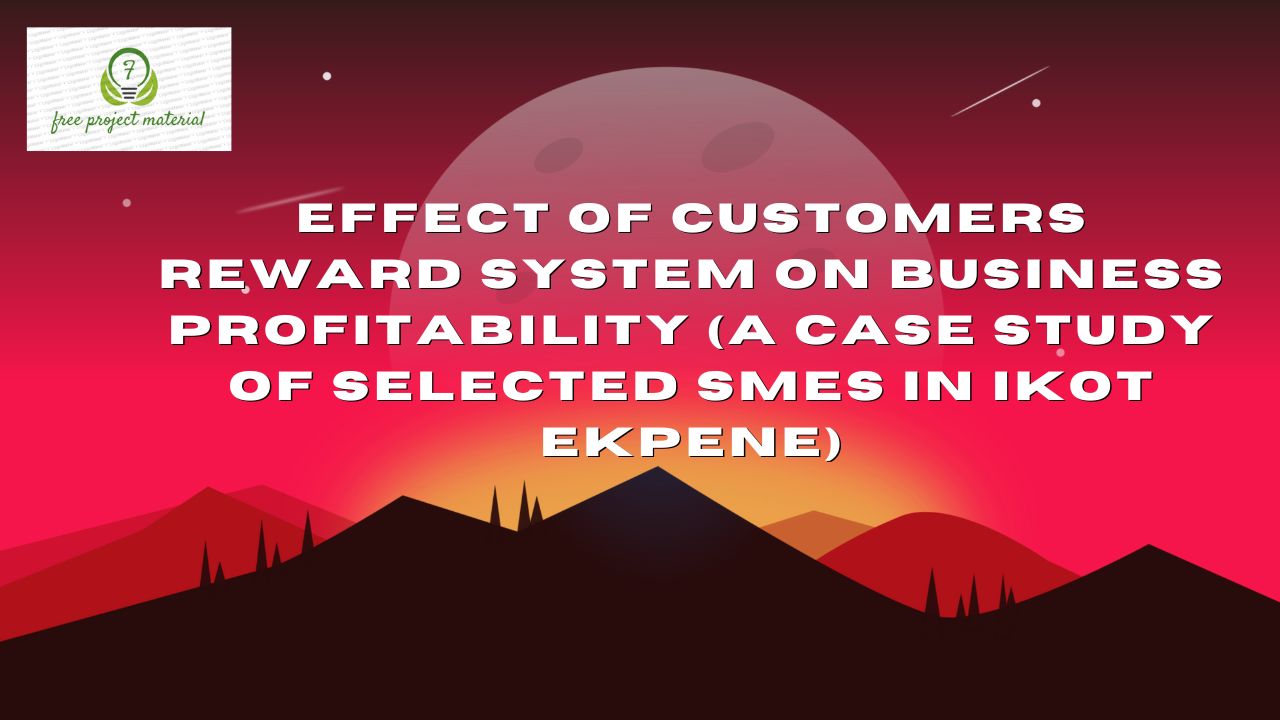ABSTRACTS
This research work focused on Effects of Customers Reward System on Business Profitability. (A case study of selected SMEs in Ikot Ekpene Local Government Area). To achieve the research objectives, the study made use of survey research design. Taro Yamene formular was used to select forty four (44) respondents as sample size for the study. The instrument of data collection was self- developed questionnaire and the forms were personally administered. Simple frequency tables and percentages were used to analyzed the data. The findings revealed that point-based programs has positive effects on business profitability, That tiered loyalty programs has positive impacts on business profitability, That paid programs has positive effects on business profitability and that value-based programs has positive impacts on business profitability. Useful recommendations were offered which were that Business should endeavour to indulge in customers reward programs if they are kin about repeated purchase, customers engagement and profitability. The managers should ensure that they use the right reward program for their businesses.
LIST OF TABLES
Table 4.1.1 Response to Research Question (1)……. 34
Table 4. 1.2 Responses to Research Question (2). …. 36
Table 4.1.3 Response to Research Question (3)…….. 37
Table 4. 1.4 Responses to Research Question (4)……. 39
TABLE OF CONTENTS
Title page – – – – – – – – – i
Approved page – – – – – – – – ii
Certification – – – – – – – – iii
Dedication – – – – – – – – – iv
Acknowledgement – – – – – – – v
Abstract – – – – – – – – – vi
List of Tables – – – – – – – – vii
Table of Contents – – – – – – – – viii
CHAPTER ONE
INTRODUCTION
1.1 Background of the Study – – – – – – 1
1.2 Statement of the Problem – – – – – – 2
1.3 Objectives of the study – – – – – – 3
1.4 Research Questions – – – – – – – 4
1.5 Scope of the Study – – – – – – – 4
1.6 Significance of the Study – – – – – – 4
1.7 Limitations of the Study – – – – – – 5
1.8 Organization of the Study – – – – – – 6
1.9 Definition of Terms – – – – – – – 6
CHAPTER TWO
REVIEW OF RELATED LITERATURE
2.1 Conceptual Framework – – – – – – 8
2.1.1 Customer loyalty – – – – – – – 8
2.1.2 Customer loyalty programmes – – – – – 9
2.1.3 Importance of customer loyalty in Business – – – 10
2.1.4 Strategies to Boost the Customer Loyalty – – – 12
2.1.5 Benefits of Customer Loyalty Programs – – – 15
2.1.6 The Effect of Customer Loyalty Programs on
Financial Performance – – – – – – 16
2.1.7 Factors Governing the Effectives of Loyalty Programs – 18
2.1.8 Types of Reward Programs – – – – – 22
2.1.9 Customer Loyalty Programs – – – – – 23
2.2 Theoretical Framework – – – – – – 24
2.2.1 Commitment Trust Theory – – – – – 24
2.2.2 Customer Loyalty Theory – – – – – 25
2.3 Empirical Framework – – – – – – 27
CHAPTER THREE
RESEARCH METHODOLOGY
3.1 Research Design – – – – – – – 29
3.2 Population of the Study – – – – – – 29
3.3 Sampling Size – – – – – – – 29
3.4 Instrumentation – – – – – – – 31
3.5 Method of Date Analysis – – – – – – 32
3.6 Problems of Data Collection – – – – – – 32
CHAPTER FOUR
DATA PRESENTATION ANALYSIS AND INTERPRETATION
4.1 Analysis of Research Questions – – – – – 34
4.1.1 Analysis of Research Question One – – – – 34
4.1.2 Analysis of Research Question Two – – – – 36
4.1.3 Analysis of Research Question Three – – – 37
4.1.4 Analysis of Research Question Four – – – – 39
4.2 Discussion of Findings – – – – – – 40
CHAPTER FIVE
SUMMARY, CONCLUSION AND RECOMMENDATIONS
5.1 Summary of Findings – – – – – – 43
5.2 Conclusion – – – – – – – – 44
5.3 Recommendations – – – – – – – 44
References
Appendix I
Appendix II
CHAPTER ONE
INTRODUCTION
1.1 Background of the Study
Owing to globalization and vibrant competitive markets, a big number of organizations are putting a lot of effort in providing additional value to their customers and quality improvement of their products (Sugandhi, 2003). Companies all over the world are presently using loyalty programs more frequently than ever before. These organizations are knowledgeable of the value retaining old customers and opt to employ a system directly aimed at developing customer loyalty. Sundar and Varardarajan (1993) proposed that retail loyalty programs emerged when retailers realized that with no customer identification tool, they were not in position of recognizing individual customer award them for their desired behaviors. Loyalty programs accomplish two functions: to entice new customers to stick around after purchasing the organization goods and service and to ensure that old loyal customers still feel valued by the organization operation. By instituting a loyal program, the organization does not only improve customer appreciation of the organization business, but also increase the chances that the old customers will share this delight with those closely related to them (Sugandhi, 2003).
The more a client feels valued by a business, the more the likelihood of that client to support that company and refer other customer to it. This translates to word-of-mouth advertisement of the business which leads to its growth. The end results of such activities are expansion of market share of the business resulting to increased profitability. Both business establishments and consumers have released the importance of loyalty programs. Stone and Woodcock (2000) demonstrated that only 12%-15% are loyal to a single business. The gross margin of an organization dictates how much fund is available for the organization to invest into loyalty program for both soft and hard benefits. Stone and Woodcock (2000) concluded that companies make heavy investments in loyalty programs have a high likelihood to attract and motivate more clients as compared to those companies that make less investment in loyalty programs. This increases regular sales and profitability of the company.
1.2 Statement of the Problem
Loyalty programs or customer rewards serve a great purpose in most organization across the world. To achieve constant sales a firm has to maintain and sustain a good relationship with its customers. Loyalty programs are intended to recognize loyal customers and motivate them thereby creating a culture of continuously buying the company’s products and services. Bitner (2002) noted that loyalty programs are used as a tool to motivate customers to buy goods and services to achieve constant sales and boost profitability. These programs act as a follow up to ascertain that clients are contented with the services and goods offered and therefore increase chances of repeated business by those customers, and this enhance sales and profitability of the firm (Tanur, 2007). Studies carried out so far seemed to limit themselves on customer retention loyalty and also quality services as none has so far investigated the relationship between the customer reward and the profitability of business. This study therefore attempted to find an answer to the question. What is the effect of customer reward on the profitability of business in Ikot Ekpene.
1.3 Objectives of the Study
- To determine the effects of point-based programs on business profitability
- To investigate the impact of tiered loyalty programs on business profitability
- To examine the effect of paid programs on business profitability
- To determine the impact of value-based programs on business profitability
1.4 Research Questions
- What are the effects of point-based programs on business profitability?
- What are the impacts of tiered loyalty programs on business profitability?
- What are the effects of paid programs on business profitability?
- What are the impacts of value-based programs on business profitability?
1.5 Scope of the Study
The scope of this research work is on effect of customers reward system on business profitability using selected SMES in Ikot Ekpene as a case study
1.6 Significance of the Study
The findings of this study are beneficial to small and medium scale business. The findings of this study will serve as an eye opener on the benefits of customer relationship management. The firms will learn the importance of customer reward system and its impact on profitability of the firm.
Policy makers and other regulatory bodies might find this piece of work relevant as findings of this study may inform policy setting especially in promoting loyalty programmes for improved sales and profitability.
1.7 Limitations of the Study
In carrying out a research work successfully is a great achievement, because several constrains or set back that may affect such research, such as encountered by the researcher include:
- Conflicts arising from cultural bias: Researchers might hold biased views due to their cultural background or perspectives of certain phenomena, and this can affects a study’s legitimacy.
- Limited access to data: if your research involved surveying certain people or organization, you might have faced the problem of having limited access to these respondents.
- Time Constraints: Just as students have deadlines to turn in their class papers, academic researchers might also have to meet deadlines for submitting a manuscript to a journal or face other time constraints related to their research.
1.8 Organization of the Study
This study is organized into five chapters; chapter one which is the introduction comprises of the background of the study, statement of the problem, objectives of the study. Research questions, scope of the study, limitations of the study, organization of the study and definition of terms.
Chapter two deals with the review of related literature on the subject matter that is the contribution of scholars and authors on the subject matter.
Chapter three describes the research design and methodology, population of the study, sample and sampling techniques, instrumentation method/plan of data analysis and problems of data collection.
Chapter four is concerned with data presentation, analysis and interpretation.
Chapter five give the summary of findings, conclusion and recommendation.
1.9 Definition of Terms
- Point-based programs: This involves rewarding customers with points for each purchase, making them popular in retail environments, like restaurants.
- Tiered loyalty programs: They are customers incentive strategies that help business in encouraging their consumers to interact with all aspect of the program in order to build brand loyalty.
- Paid programs: In paid loyalty programs, members pay a recurring fee to receive great benefits they can use right away.
- Value-based programs: Mostly used in rewarding health care providers and may include incentive payments for the quality of care they give to people with medicare.
- Customers: An individual or business that purchases another company’s goods or services.
- Customers loyalty: A measure of a customer’s likeliness to do repeat business with a company or brand.
- Customers loyalty programs/reward system: A marketing approach that recognizes and rewards customers who purchase or engage with a brand on a recurring basis. A company may dash out points or parks, and graduate customers to higher levels of loyalty the more they buy.


